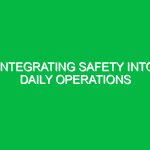In today’s fast-paced work environments, the importance of health, safety, and environmental (HSE) practices cannot be overstated. One crucial aspect of fostering a culture of safety is recognizing and rewarding safety behaviors. This practice not only encourages employees to prioritize safety but also reinforces the idea that every individual has a role to play in maintaining a safe workplace. In this article, we will explore the significance of recognizing and rewarding safety behaviors, potential hazards associated with these practices, and actionable strategies to implement effective recognition and reward systems.
The Importance of Recognizing and Rewarding Safety Behaviors
Recognizing and rewarding safety behaviors involves acknowledging individuals or teams that demonstrate exemplary safety practices. Such recognition can take various forms, including verbal praise, awards, or even financial incentives. The primary goal is to cultivate an environment where safety is a shared responsibility, ultimately reducing workplace accidents and improving overall morale.
When employees feel valued for their commitment to safety, they are more likely to engage in safe practices consistently. This approach aligns with the principles of positive reinforcement, which suggest that behaviors that are rewarded are more likely to be repeated. For instance, a manufacturing plant that implements a “Safety Star” program, where employees nominate their peers for safe practices, often sees a marked decrease in safety incidents. This is not just anecdotal; a study by the National Safety Council found that organizations with effective safety recognition programs have 50% fewer injuries than those without.
Understanding the Risks and Hazards
While the act of recognizing and rewarding safety behaviors is inherently positive, it is essential to acknowledge the potential hazards and risks associated with how these practices are implemented. If not done correctly, such programs can inadvertently create an environment where safety is compromised.
1. Inadvertent Pressure on Employees
One of the most significant risks is the pressure it can create. When recognition is tied solely to performance metrics, employees might feel compelled to overlook minor safety violations to meet targets. For example, in a construction setting, a worker might rush to complete a task on time, sacrificing safety checks to achieve recognition. This scenario illustrates the delicate balance needed when implementing reward systems.
2. Inequality in Recognition
Another potential hazard is the perception of favoritism. If recognition programs are not transparent and inclusive, certain employees may feel overlooked, leading to resentment. In the long run, this can diminish overall morale and create divisions within teams. It’s crucial to ensure that recognition is based on consistent criteria that everyone understands and can aspire to.
Safety Precautions and Best Practices
To mitigate the risks associated with recognizing and rewarding safety behaviors, organizations should adopt specific safety precautions and best practices. Here are several actionable strategies:
1. Develop Clear Criteria for Recognition
Establishing clear, measurable criteria for what constitutes safe behavior is vital. This could involve creating a checklist of safe practices relevant to your industry. For example, in an oil and gas company, criteria might include the proper use of personal protective equipment (PPE), adherence to safety protocols, and participation in safety meetings. By having clear guidelines, employees know exactly what they need to do to be recognized.
2. Foster a Culture of Open Communication
Encourage employees to discuss safety openly. Regular safety meetings can provide a platform for sharing experiences and lessons learned. For instance, a company in the logistics sector found that after implementing monthly safety forums, employees felt more empowered to speak up about unsafe practices. As a result, the company saw a significant drop in accidents. Open communication nurtures trust and allows for constructive feedback, which is essential for continuous improvement.
3. Provide Diverse Recognition Opportunities
Offering a variety of recognition opportunities is crucial. Not everyone responds to the same type of recognition. Some may appreciate public acknowledgment, while others might prefer a private commendation. Consider implementing a tiered recognition program that includes verbal praise, certificates, and small rewards. This approach caters to individual preferences and increases the likelihood of engagement.
4. Use Technology to Facilitate Recognition
Leveraging technology can streamline recognition processes. For example, a mobile app that allows employees to nominate peers for safety awards can make the process more accessible and engaging. Such platforms can also provide real-time feedback and updates on safety performance metrics, reinforcing the importance of safe behaviors continuously. Technology can create a more dynamic and interactive recognition environment.
Regulations and Standards Governing Safety Recognition
Several regulations and standards govern safety practices in the workplace. Understanding these can help organizations align their recognition programs with legal requirements while promoting a culture of safety. The Occupational Safety and Health Administration (OSHA) sets forth regulations that emphasize the need for safety training and recognition of safe practices. Additionally, industry standards such as ISO 45001 outline requirements for occupational health and safety management systems, which can include employee recognition as a key element.
Moreover, organizations must ensure they are in compliance with local regulations, which may vary by region. This compliance not only protects employees but also shields the organization from potential legal repercussions. Regular audits and training sessions can help maintain adherence to these standards.
Measuring the Impact of Recognition Programs
To ensure that recognizing and rewarding safety behaviors is effective, organizations should implement measurement systems to evaluate the impact of their programs. Key performance indicators (KPIs) can include the number of reported safety incidents, employee engagement scores, and feedback from staff surveys. For instance, a construction firm that tracked these metrics found that after launching a safety recognition program, their incident reports decreased by 30% within the first year.
Additionally, organizations should regularly solicit feedback on their recognition programs. This feedback can help identify areas for improvement and ensure that the program remains relevant and effective. Continuous evaluation fosters a culture of adaptability, allowing the organization to evolve with changing safety dynamics.
Conclusion
Recognizing and rewarding safety behaviors is not just a nice-to-have; it is a critical component of any effective health, safety, and environment strategy. By implementing thoughtful recognition programs, organizations can foster a culture where safety is prioritized, ultimately leading to decreased incidents and increased employee morale. However, it is essential to navigate the potential hazards associated with these programs carefully. With clear criteria, open communication, diverse recognition strategies, and a focus on continuous improvement, companies can create a thriving safety culture that benefits everyone involved. By doing so, they not only comply with regulations and standards but also invest in the most valuable asset they have—their people.


